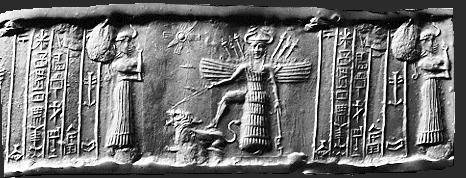
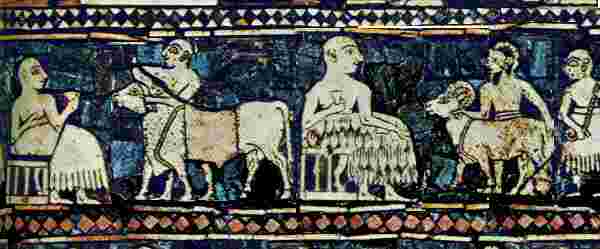
Information about Sumerian Gods and Goddesses is found on the Sumerian King List as well as Sumerian clay tablets and cylinder seals. The Sumerian King List records all the rulers of Earth back over 400,000 years. This huge stretch of time coupled with reigns into the thousands of years has caused most historians to reject its accuracy. However all the early rulers were allegedly gods - demi-gods or immortals.
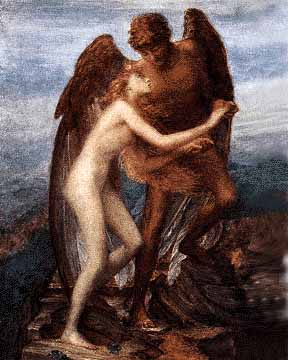
These Gods were called the Nephilim - Nefilim - Elohim - Annunaki meaning "Those who from Heaven to Earth came." In Sumerian Mythology they were a pantheon of good and evil gods and goddesses who came to Earth to create the human race. According to the some resources, these gods came from Nibiru - 'Planet of the Crossing.' The Assyrians and Babylonians called it 'Marduk', after their chief god. Sumerians said one year on planet Nibiru, a sar, was equivalent in time to 3600 Earth years. Annunaki lifespans were 120 sars which is 120 x 3600 or 432,000 years. According to the King List - 120 sars had passed from the time the Annunaki arrived on Earth to the time of the Flood.
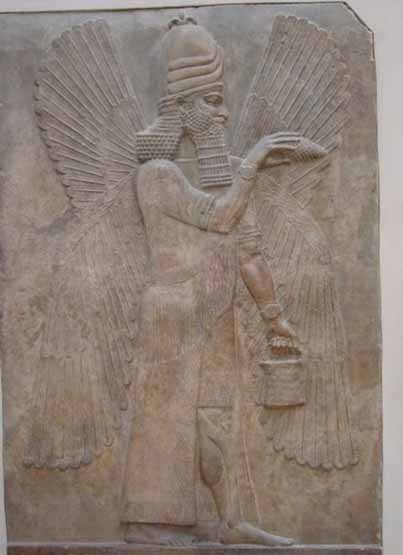
Gods With Water Buckets
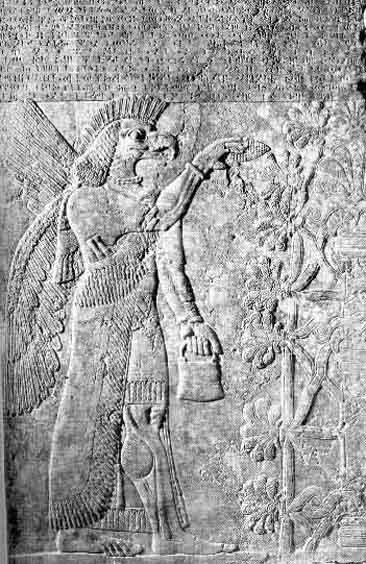
The Tree of Life
The Annunaki are sometimes depicted as humanoid. At other times they are bird-headed with wings [Symbology - evolution of consciousness - return to higher frequency of thought - alchemy]. Often they are Reptilian in appearance especially when depicted as warriors - [Reptilian Symbology - snake - dragons - reptiles = DNA - creation of the human bi-polar experiment.] Sometimes they are shown as a combination of several types of entities. All is myth, math, and metaphor, so look for the clues in every set of gods you read about, as they all follow the same patterns that repeat in cycles or loops called Time. The patterns of their battles reflect reality as duality and are found within every pantheon of gods - the same characters playing different roles.
A Sumerian tablet shows Enmeduranki, a prince in Sippar, who was well loved by Anu, Enlil and Ea. Shamash, a priest in the Bright Temple, appointed him then took him to the assembly of the gods. They showed him how to observe oil on water and many other secrets of Anu, Enlil and Ea. Then they gave him the Divine Tablet, the kibdu secret of Heaven and Earth. They taught him how to make calculations with numbers." [This is a reference to Sacred or Creational Geometry]
The Sumerians never called the Anunnaki, 'gods.' They were called din.gir, a two-syllable word. 'Din' meant 'righteous, pure, bright;' 'gir' was a term used to describe a sharp-edged object. As an epithet for the Anunnaki 'dingir' meant 'righteous ones of the bright pointed objects.'
Sumerian texts break up history into two epochs divided by the Great Deluge - the Biblical Flood. After the waters receded the great Anunnaki who decree the fate decided that the gods were too lofty for mankind. The term used - 'elu' in Akkadian - means exactly that: 'Lofty Ones;' from it comes the Babylonian, Assyrian, Hebrew, and Ugaritic El - the term to which the Greeks gave the connotation 'god'.
From Genesis:
After the sons of God took human wives there were giants in the Earth in those days; and also after that, when the sons of God came in unto the daughters of men, and they bare children to them, the same became the mighty men which were of old, men of renown. The Nefilim were upon the Earth, in those days and thereafter too, when the sons of the gods cohabitated with the daughters of the Adam, and they bore children unto them. They were the mighty ones of Eternity - the people of the shem.' Nefilim stems from the Semitic root NFL, 'to be cast down.'
The Sumerians believed in their gods and saw the intentions of their gods as good and powerful beings who controlled their world. The Sumerians explanation for their hardships and misfortunes were the result of human deeds that displeased the gods - in a word, sin. They believed that when someone displeased the gods, these gods let demons punish the offender with sickness, disease or environmental disasters.
The Sumerians experienced infrequent rains that sometimes created disastrous floods, and they believed that these floods were punishments created by a demon god that lived in the depths of the Gulf of Persia. And to explain the misfortunes and suffering of infants, the Sumerians believed that sin was inborn, that never was a child born without sin. Therefore, wrote a Sumerian, when one suffered it was best not to curse the gods but to glorify them, to appeal to them, and to wait patiently for their deliverance.
In giving their gods human characteristics, the Sumerians projected onto their gods the conflicts they found among themselves. Sumerian priests wrote of a dispute between the god of cattle, Lahar, and his sister Ashnan, the goddess of grain. Like some other gods, these gods were vain and wished to be praised. Each of the two sibling gods extolled his and her own achievements and belittled the achievements of the other.
The Sumerians 'saw' another dispute between the minor gods Emesh (summer) and his brother Enten (winter). Each of these brothers had specific duties in creation - like Cain the farmer and Able the herdsmen. The god Enlil put Emesh in charge of producing trees, building houses, temples, cities and other tasks. Enlil put Enten in charge of causing ewes to give birth to lambs, goats to give birth to kids, birds to build nests, fish to lay their eggs and trees to bear fruit. And the brothers quarreled violently as Emesh challenged Enten's claim to be the farmer god.
A dispute existed also between the god Enki and a mother goddess, Ninhursag -- perhaps originally the earth goddess Ki. Ninhursag made eight plants sprout in a divine garden, plants created from three generations of goddesses fathered by Enki.
These goddesses were described as having been born "without pain or travail." Then trouble came as Enki ate the plants that Ninhursag had grown. Ninhursag responded with rage, and she pronounced a curse of death on Enki, and Enki's health began to fail. Eight parts of Enki's body - one for each of the eight plants that he ate - became diseased, one of which was his rib.
The goddess Ninhursag then disappeared so as not let sympathy for Enki change her mind about her sentence of death upon him. But she finally relented and returned to heal Enki. She created eight healing deities - eight more goddesses - one for each of Enki's ailing body parts. The goddess who healed Enki's rib was Nin-ti, a name that in Sumerian meant "lady of the rib," which describes a character who was to appear in a different role in Hebrew writings centuries later, a character to be called Eve.
THE FOUR PRIMARY GODS

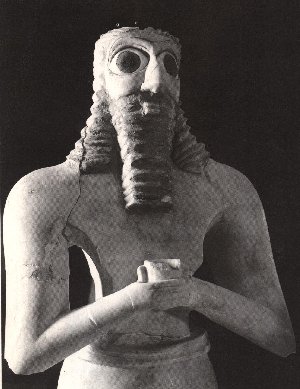
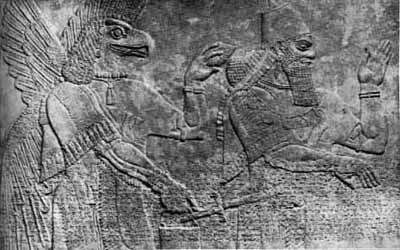
In Sumerian mythology and later for Assyrians and Babylonians, Anu was a sky-god, the god of heaven, lord of constellations, king of gods, spirits and demons, and dwelt in the highest heavenly regions. It was believed that he had the power to judge those who had committed crimes, and that he had created the stars as soldiers to destroy the wicked. He was the father of the Anunnaku (also spelled Anunnaki). In art he was sometimes depicted as a jackal. His attribute was the royal tiara, most times decorated with two pairs of bull horns.
He was also called An.
- In Sumerian mythology, An was the god whose name was synonymous with the sun's zenith, or heaven. He was the oldest god in the Sumerian pantheon, and part of a triad including Enlil, god of the sky and Enki, god of water. He was called Anu by the Akkadians, rulers of Mesopotamia after the conquest of Sumer in 2334 BCE by King Sargon of Akkad.
In Sumerian mythology and later for Assyrians and Babylonians, Anu was a sky-god, the god of heaven, lord of constellations, king of gods, spirits and demons, and dwelt in the highest heavenly regions. It was believed that he had the power to judge those who had committed crimes, and that he had created the stars as soldiers to destroy the wicked. He was the father of the Anunnaku (also spelled Anunnaki). In art he was sometimes depicted as a jackal. His attribute was the royal tiara, most times decorated with two pairs of bull horns.
By virtue of being the first figure in a triad consisting of Anu, Bel and Ea, Anu came to be regarded as the father and king of the gods. Anu is so prominently associated with the city of Erech in southern Babylonia that there are good reasons for believing this place to have been the original seat of the Anu cult. If this be correct, then the goddess Nana (or Ishtar) of Erech was presumably regarded as his consort.
The name of the god signifies the "high one" and he was probably a god of the atmospheric region above the earth--perhaps a storm god like Adad. However this may be, already in the old-Babylonian period, i.e. before Khammurabi, Anu was regarded as the god of the heavens and his name became in fact synonymous with the heavens, so that in some cases it is doubtful whether, under the term, the god or the heavens is meant.
It would seem from this that the grouping of the divine powers recognized in the universe into a triad symbolizing the three divisions, heavens, earth and the watery-deep, was a process of thought which had taken place before the third millennium.
To Anu was assigned the control of the heavens, to Bel the earth, and to Ea the waters.
The doctrine once established remained an inherent part of the Babylonian-Assyrian religion and led to the more or less complete disassociation of the three gods constituting the triad from their original local limitations.
An intermediate step between Anu viewed as the local deity of Erech (or some other centre), Bel as the god of Nippur, and Ea as the god of Eridu is represented by the prominence which each one of the centers associated with the three deities in question must have acquired, and which led to each one absorbing the qualities of other gods so as to give them a controlling position in an organized pantheon.
For Nippur we have the direct evidence that its chief deity, En-lil or Bel, was once regarded as the head of an extensive pantheon. The sanctity and, therefore, the importance of Eridu remained a fixed tradition in the minds of the people to the latest days, and analogy therefore justifies the conclusion that Anu was likewise worshipped in a centre which had acquired great prominence.
The summing-up of divine powers manifested in the universe in a threefold division represents an outcome of speculation in the schools attached to the temples of Babylonia, but the selection of Anu, Bel and Ea for the three representatives of the three spheres recognized, is due to the importance which, for one reason or the other, the centers in which Anu, Bel and Ea were worshipped had acquired in the popular mind.
Each of the three must have been regarded in his centre as the most important member in a larger or smaller group, so that their union in a triad marks also the combination of the three distinctive pantheons into a harmonious whole. In the astral theology of Babylonia and Assyria, Anu, Bel and Ea became the three zones of the ecliptic, the northern, middle and southern zone respectively.
The purely theoretical character of Anu is thus still further emphasized, and in the annals and votive inscriptions as well as in the incantations and hymns, he is rarely introduced as an active force to whom a personal appeal can be made. His name becomes little more than a synonym for the heavens in general and even his title as king or father of the gods has little of the personal element in it.
A consort Antum (or as some scholars prefer to read, Anatum) is assigned to him, on the theory that every deity must have a female associate, but Antum is a purely artificial product--a lifeless symbol playing even less of a part in what may be called the active pantheon than Anu.
In Hurrian mythology, Anu was the progenitor of all gods. His son Kumarbi bit off his genitals and spat out three deities, one of whom, Teshub, later deposed Kumarbi. He bit off the genitals of Anu and spat out three new gods. One of those, the storm god Teshub, later deposed Kumarbi. Scholars have pointed to the remarkable similarities between this Hurrian creation myth and the story of Ouranos, Kronos, and Zeus from Greek mythology. It's all recycled in the loops of time with the same characters playing most of the roles - or one character playing them all.
According to the Earth Chronicles series by Zecharia Sitchin, the wife of Anu was a fertility goddess and the mother of the gods; her cult was centered in Munster. However, Anu was one of the Anunnaki who came from the planet Nibiru (Marduk).
According to Sitchin's theories on Sumerian legend and lore, the Anunnaki arrived first on Earth probably 400,000 years ago, looking for minerals, especially gold, which they found and mined gold in Africa. Sitchin may have confused the Mesopotamian god Anu with the Irish goddess Anann - or are they the same?
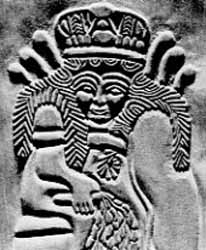

Milking scenes from the Temple of Ninhursag, - Tell al Ubaid, c. 2400 B.C.
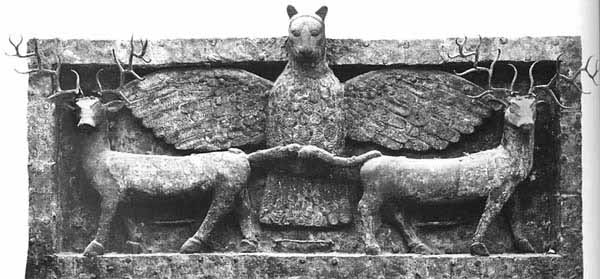
In Sumerian mythology, Ninhursag (or Ki) was the earth and mother-goddess she usually appears as the sister of Enlil. Ninhursag means 'Lady of the Foothills'. She had many other names: Nintur 'Lady Birth', Ninmah 'Lady August', Dingirmah, Aruru, and as wife of Enki was usually called Damgalnunna.
In Akkadian she was Belit-ili 'Lady of the Gods' and Mama and as wife to Ea, Enki's Akkadian counterpart, she was called Damkina. Her prestige decreased as Ishtar's increased, but her aspect as Damkina mother of Marduk, the supreme god of Babylonia, still held a secure place in the pantheon.
In union with Enki she also bore Ninsar, goddess of the pasture. She was the chief nurse, the one in charge of medical facilities. In that role that the Goddess was called NINTI (lady-life). She was considered the Mother Goddess. She was nicknamed 'Mammu' - now called 'mother' 'mom'.
Ninhursag bore a male child to Enlil. His name was NIN.UR.TA (lord who completes the fountain). He was the son who to do battle for his father using bolts of lightening.
In Egypt she played the roles of several creational goddesses - Maat -- Isis and Hathor [Cow Goddess - Milk Symbology]

Ea stands in his watery home the Apsu.
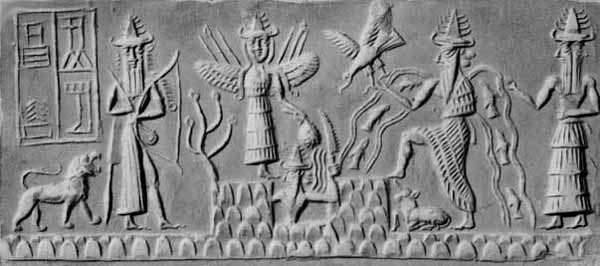
Enki walks out of the water to the land.
Enki is attended by a god with two faces called Usmu (Isimud).
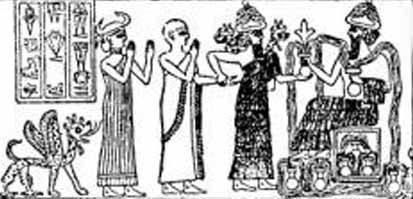
Enki with the Gods and the Initiate.
The Water of Life flowing into the laboratory glassware
indicates alchemical circulations.
Within his sacred precinct 'Mound of Creation' in Eridu, Enki unraveled the secrets of life and death. His emblem was two serpents [twin human DNA] entwined on a staff - the basis for the winged caduceus symbol used by modern Western medicine. Enki was the god who created the first humans. His sacred number is 40.
Enki was the leader of the first sons of Anu that came down to Earth. He played the pivotal role in saving humanity from the global Deluge. He defied the Anunnaki ruling council and told Ziusudra (the Sumerian Noah) how to build a ship on which to save humanity from the killing flood. Ea would have been over 120 sars old at that time, yet his activity with humanity continued to be actively reported for thousands of years thereafter.
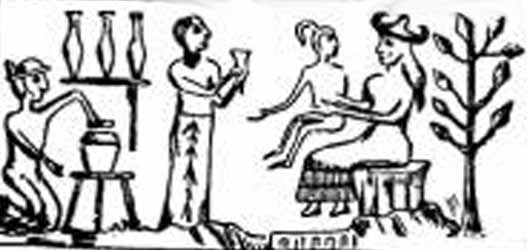
Laboratory vessels and Tree of Life
Enki's youngest son, Ningizzida, was Lord of the Tree of Truth, in Mesopotamia. He played the role of Thoth in Egypt and Hermes the Magician - the Alchemist. The ancient Mystery School Teachings of Thoth were past down to his Initiates who became the priests. They hid the secret knowledge of creation, passing it down through the ages - Sacred Geometry.
Enki was a deity in Sumerian mythology, later known as Ea in Babylonian mythology. The name Ea is of Sumerian origin and was written by means of two signs signifying "house" and "water". Enki was the deity of water, intelligence and creation. The main temple of Enki was the so-called é-engur-ra, the "house of the (water-)deep"; it was in Eridu, which was in the wetlands of the Euphrates valley at some distance from the Persian Gulf. He was the keeper of the holy powers called Me. The exact meaning of his name is not sure: the common translation is "Lord of the Earth": the Sumerian en is translated as "lord", ki as "earth"; but there are theories that ki in this name has another origin.He is the lord of the Apsu, the watery abyss. His name is possibly an epithet bestowed on him for the creation of the first man, [Adamu or Adapa. His symbols included a goat and a fish, which later combined into a single beast, the Capricorn, which became one of the signs of the zodiac. Enki had a penchant for beer and a string of incestuous affairs. First, he and his consort Ninhursag had a daughter Ninsar. He then had intercourse with Ninsar who gave birth to Ninkurra. Finally, he had intercourse with Ninkurra, who gave birth to Uttu.
According to Sumerian mythology, Enki allowed humanity to survive the Deluge designed to kill them. After Enlil, An and the rest of the apparent Council of Deities, decided that Man would suffer total annihilation, he covertly rescued the human man Ziusudra by either instructing him to build some kind of an boat for his family, or by bringing him into the heavens in a magic boat. This is apparently the oldest surviving source of the Noah's Ark myth and other parallel Middle Eastern Deluge myths.
Enki was considered a god of life and replenishment, and was often depicted with streams of water emanating from his shoulders. Alongside him were trees symbolizing the male and female aspects of nature, each holding the male and female aspects of the 'Life Essence', which he, as apparent alchemist of the gods, would masterfully mix to create several beings that would live upon the face of the Earth.
Eridu, meaning "the good city", was one of the oldest settlements in the Euphrates valley, and is now represented by the mounds known as Abu Shahrein. In the absence of excavations on that site, we are dependent for our knowledge of Ea on material found elsewhere. This is, however, sufficient to enable us to state definitely that Ea was a water-deity, lord especially of the water under the earth, the Apsu. Whether Ea (or A-e as some scholars prefer) represents the real pronunciation of his name we do not know.
Older accounts sometimes suppose that by reason of the constant accumulation of soil in the Euphrates valley Eridu was formerly situated on the Persian Gulf itself (as indicated by mention in Sumerian texts of its being on the Apsu), but it is now known that the opposite is true, that the waters of the Persian Gulf have been eroding the land and that the Apsu must refer to the fresh water of the marshes surrounding the city.
Ea is figured as a man covered with the body of a fish, and this representation, as likewise the name of his temple E-apsu, "house of the watery deep", points decidedly to his character as a god of the waters. Of his cult at Eridu, which goes back to the oldest period of Babylonian history, nothing definite is known except that his temple was named Esaggila = "the lofty house", pointing to a staged tower (as with the temple of Enlil at Nippur, which was known as Ekur = "mountain house"), and that incantations, involving ceremonial rites, in which water as a sacred element played a prominent part, formed a feature of his worship.
Whether Eridu at one time also played an important political role is not certain, though not improbable. At all events, the prominence of the Ea cult led, as in the case of Nippur, to the survival of Eridu as a sacred city, long after it had ceased to have any significance as a political center. Myths in which Ea figures prominently have been found in Assurbanipal's library, indicating that Ea was regarded as the protector and teacher of mankind. He is essentially a god of civilization, and it was natural that he was also looked upon as the creator of man, and of the world in general.
Traces of this view appear in the Marduk epic celebrating the achievements of this god, and the close connection between the Ea cult at Eridu and that of Marduk also follows from two considerations:
- the name of Marduk's sanctuary at Babylon bears the same name, Esaggila, as that of Ea in Eridu
- Marduk is generally termed the son of Ea, who derives his powers from the voluntary abdication of the father in favor of his son.
It is, however, more particularly as the third figure in the triad, the two other members of which were Anu and Enlil, that Ea acquires his permanent place in the pantheon. To him was assigned the control of the watery element, and in this capacity he becomes the shar apsi, i.e. king of the Apsu or "the deep." The Apsu was figured as the abyss of water beneath the earth, and since the gathering place of the dead, known as Aralu, was situated near the confines of the Apsu, he was also designated as En-Ki, i.e. "lord of that which is below", in contrast to Anu, who was the lord of the "above" or the heavens.
The cult of Ea extended throughout Babylonia and Assyria. We find temples and shrines erected in his honor, e.g. at Nippur, Girsu, Ur, Babylon, Sippar and Nineveh, and the numerous epithets given to him, as well as the various forms under which the god appears, alike bear witness to the popularity which he enjoyed from the earliest to the latest period of Babylonian-Assyrian history.
The consort of Ea, known as Damkina, "lady of that which is below," or Damgalnunna, "great lady of the waters," represents a pale reflection of Ea and plays a part merely in association with her lord.
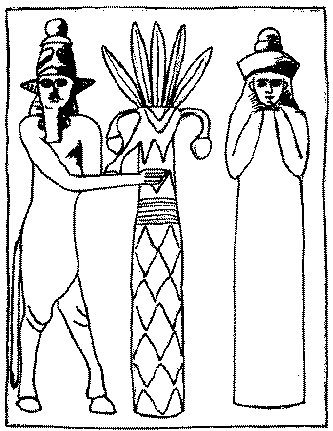
Enlil was the name of a chief deity in Babylonian religion, perhaps pronounced and sometimes rendered in translations as Ellil in later Akkadian. The name is Sumerian and has been believed to mean 'Lord Wind' though a more literal interpretation is 'Lord of the Command'.
Enlil was the god of wind, or the sky between earth and heaven. One story has him originate as the exhausted breath of An (God of the heavens) and Ki (goddess of the Earth) after sexual union. Another accounts is that he and his sister Ninhursag/Ninmah/Aruru were children of an obscure god Enki 'Lord Earth' (not the famous Enki) by Ninki 'Lady Earth'.
When Enlil was a young god, he was banished from Dilmun, home of the gods, to Kur, the underworld for raping a young girl named Ninlil. Ninlil followed him to the underworld where she bore his first child, the moon god Sin. After fathering three more underworld deities, Enlil was allowed to return to Dilmun.
Enlil was also known as the inventor of the pickaxe/hoe (favorite tool of the Sumerians) and the cause of plants growing. He was in possession of the holy Me, until he gave them to Enki for safe keeping, who summarily lost them to Inanna in a drunken stupor.
Enlil's relation to An 'Sky', in theory the supreme god of the Sumerian pantheon, was somewhat like that of a Frankish mayor of the palace compared to the king, or that of a Japanese shogun compared to the emperor, or to a prime minister in a modern constitutional monarchy compared to the supposed monarch. While An was in name ruler in the highest heavens, it was Enlil who mostly did the actual ruling over the world.
By his wife Ninlil or Sud, Enlil was father of the moon god Nanna (in Akkadian Sin) and of Ninurta (also called Ningirsu). Enlil is sometimes father of Nergal, of Nisaba the goddess of grain, of Pabilsag who is sometimes equated with Ninurta, and sometimes of Enbilulu. By Ereshkigal Enlil was father of Namtar.
Enlil is associated with the ancient city of Nippur, and since Enlu with the determinative for "land" or "district" is a common method of writing the name of the city, it follows, apart from other evidence, that Enlil was originally the patron deity of Nippur.
At a very early period - prior to 3000 BC - Nippur had become the centre of a political district of considerable extent. Inscriptions found at Nippur, where extensive excavations were carried on during 1888-1900 by Messrs Peters and Haynes, under the auspices of the University of Pennsylvania, show that Enlil was the head of an extensive pantheon. Among the titles accorded to him are "king of lands," "king of heaven and earth" and "father of the gods".
His chief temple at Nippur was known as Ekur, signifying 'House of the mountain', and such was the sanctity acquired by this edifice that Babylonian and Assyrian rulers, down to the latest days, vied with one another in embellishing and restoring Enlil's seat of worship, and the name Ekur became the designation of a temple in general.
Grouped around the main sanctuary, there arose temples and chapels to the gods and goddesses who formed his court, so that Ekur became the name for an entire sacred precinct in the city of Nippur.
The name "mountain house" suggests a lofty structure and was perhaps the designation originally of the staged tower at Nippur, built in imitation of a mountain, with the sacred shrine of the god on the top.
When, with the political rise of Babylon as the centre of a great empire, Nippur yielded its prerogatives to the city over which Marduk presided, the attributes and the titles of Enlil were largely transferred to Marduk.
But Enlil did not, however, entirely lose his right to have any considerable political importance, while in addition the doctrine of a triad of gods symbolizing the three divisions - heavens, earth and water - assured to Enlil, to whom the earth was assigned as his province, his place in the religious system.
It was no doubt in part Enlil's position as the second figure of the triad that enabled him to survive the political eclipse of Nippur and made his sanctuary a place of pilgrimage to which Assyrian kings down to the days of Assur-bani-pal paid their homage equally with Babylonian rulers.
The Sumerian ideogram for Enlil or Ellil was formerly incorrectly read as Bel by scholars, but in fact Enlil was not especially given the title Bel 'Lord' more than many other gods.
The Babylonian god Marduk is mostly the god persistently called Bel in late Assyrian and Babylonian inscriptions and it is Marduk that mostly appears in Greek and Latin texts as Belos or Belus. References in older literature to Enlil as the old Bel and Marduk as the young Bel derive from this error in reading.
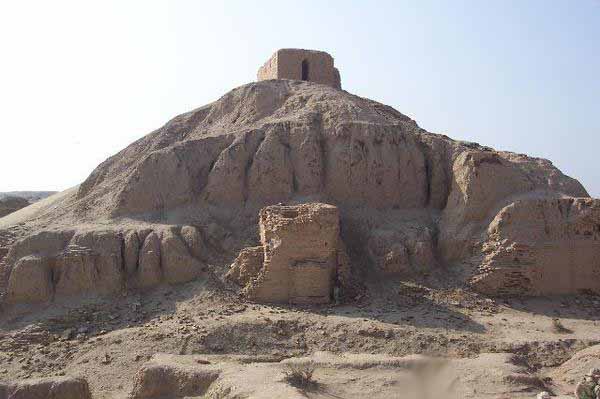
In Akkadian mythology and Sumerian mythology, Anshar (also Anshur, Ashur, Asshur) is the sky god. He is the husband of his sister Kishar; they are the children of Lahmu and Lahamu, and the parents of Anu and Ea (and, in some traditions, Enlil). He is sometimes depicted as having Ninlil as a consort. As Anshar, he is progenitor of the Akkadian pantheon; as Ashur, he is the head of the Assyrian pantheon. Anshar led the gods in the war against Tiamat.
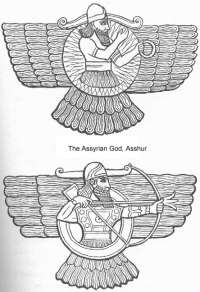
Winged Assur is portrayed looking like the Faravahar or Zoroaster (Z).
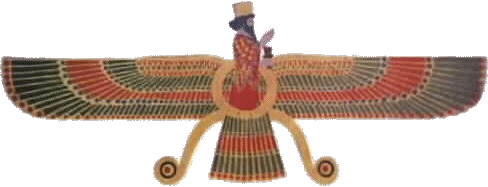

0 comments:
Post a Comment